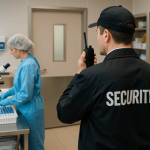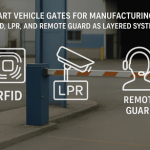Security For Hospital Support Spaces: Labs, Sterile Processing, And Central Supply
When people think about hospital security, they usually picture emergency departments, entrances, and patient units. Those areas absolutely matter, but there is a quiet part of the hospital that often carries just as much risk: the support spaces. Labs, sterile ...
Smart Vehicle Gates for Manufacturing: RFID, LPR, and Remote Guard as a Layered System
Your vehicle gate is more than a barrier. It decides who gets near people, product, and critical assets. For many manufacturing sites, that decision still relies on a single method at a single point in time. A badge scan or ...
How Integrated Security Lowers Multifamily Insurance Premiums
Premiums follow risk. Integration reduces risk. Carriers price two things on your property. The likelihood that an incident occurs and the severity when it does. Integrated security systems cut both by preventing more events in the first place and documenting ...
Search That Works: Natural-Language and Attribute Search in Modern VMS
If you have ever scrubbed through hours of video to find a single moment, you know why better search matters. The good news is that today’s video management systems do more than time and camera filters. With natural-language search and ...
Protecting An Empty Campus Over The Holidays
Holiday concerts wind down, travel picks up, and your campus grows quiet. An empty private school can be peaceful, but it is also more vulnerable. Fewer people on site means slower detection of problems and fewer hands to respond. The ...
From Dock Door to Delivery: Linking LPR, GPS, and Video for Chain of Custody
Every handoff in the supply chain is a trust moment. A pallet leaves a dock door, crosses the yard, passes the gate, hits the highway, stops at a cross-dock, and lands at the customer. If you cannot prove what happened ...
Integrating Nurse Call, RTLS, and Security Systems for Faster Response
In a hospital, seconds matter. When a patient falls, a behavioral health situation escalates, or a staff member feels unsafe, the speed and clarity of the response can make all the difference. Most hospitals already have strong pieces of the ...
Digital Twins for Security and EHS: Live Floorplans That Help You Act Faster
Most plants already have pieces of a digital twin without calling it that. You have cameras with maps, access control door groups, sensor dashboards, and evacuation routes. The problem is that these pieces usually sit in separate systems. During an ...
Security as a Service for Multifamily Teams
The DIY burden is real Leasing and maintenance teams already juggle tours, turns, vendors, and resident requests. When they also become the access control help desk, performance slips. Keys go missing. Fobs multiply. Guest and vendor passes vary from one ...
Device Health as a KPI: Proactive Maintenance for Cameras, Readers, and Controllers
Most security programs focus on incidents, alarms, and investigations. What often gets ignored is the quiet foundation that makes all of that work. If a camera is down, a card reader is offline, or a controller is running outdated firmware, ...


